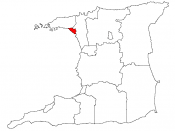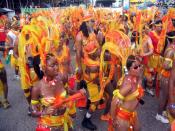Returning to Your Roots: The Integration of Calypso in Miguel Street Many writers, whether they have left their homeland to a Western society or have been born into one, find that they can not fully escape from their culture; often times they can not help but to reflect a part of their culture into their writing. V.S. Naipaul, a Trinidadian writer who left his homeland for a life in England still goes back to his origin of language, form and setting in his novel Miguel Street. The novel consists of a collection of amusing yet sad vignettes about colourful, poor Trinidadians full of bold scheme talk in rhythmic and lively ungrammatical English. This content and setting, ideal for the presence of a Trinidadian form of expression called calypso, is orchestrated into the novel. Calypso is a style of music in West Indies, more specifically in Trinidad, marked by lively duple meter, where the lyrics are given priority over the melody.
The significance of it is that it tells a story and makes a flattering or satirical comment about the people and events that are generally being talked about. Throughout the novel the residents of Miguel Street liberally quote from old and new calypsoes which are directly related to the central themes of their stories; the use of calypso brings validation and authority in their stories as well as provide a means of a flattering or satirizing political weapon.
The word ?calypso? is an old Greek word meaning ?to hide something? (Sealey 24). Calypso dates back to the time of slavery when ?[s]laves were not supposed to have any opinions of their own because it was thought to be dangerous to their white masters and could be punished. So [they] made up verses and rhymes with a double meaning? (Sealey 24). In this respect it spread opinions on different matters quickly. A lot of Trinidad?s history and culture have been recorded in the lyrics of calypso; specific calypso allusions reflect the way in which the lyrics satirize the many biting social comments. One popular theme is the battle of the sexes where men are obsessed with succeeding to be a ?proper man? (Naipaul 17) by the standard of the other characters. Popo, the carpenter was not popular in the streets and was considered a ?man-woman?. However, he gains his popularity as he resorts to heavy drinking after his wife, Emelda, leaves him. The reality of the situation is, of course, that Popo was not doing fine without her and leaves the street to win her back. This leads to his becoming the subject of a popular calypso: A certain carpenter feller went to Arima Looking for a mopsy called Emelda. (Naipaul 19) On his return to Miguel Street, Popo finds that he is no longer respected for his manliness because now he has shown his dependence on woman. But when he steals furniture and paint to improve his home for Emelda, and sent to jail he gained recognition again as a ?[real] a man, perhaps a bigger man them any of us? (Naipaul 20). Jail, like heavy drinking, automatically establishes one?s masculinity in the streets. Popo, with the help of the calypso, becomes a hero as the headline in the newspaper reads: ?CALYPSO CARPENTER JAILED? (Naipaul 20). The dominant pattern of the stories is centered on an ironic exposure of the pretence of manliness and through the use of calypso Naipaul satirizes their definition.
In ?The Maternal Instinct,? Nathanial gives the impression that ?he knew how to keep Laura in her place? and ?hinted that he used to beat her. He used to say, ?Woman and them like a good dose of blows . . . You know the calypso: Every now and then just knock them down.
Every now and then just knock them down.
Black up their eye and bruise up their knee And then they love you eternally.
Is the gospel truth about woman? (Naipaul 87) Measuring up to societies idea of masculinity is a big deal to most men in Miguel Street. Men beating up on women is a natural domestic ritual and is one way to prove their manliness. It is accepted by society because it is just natural for men to take control of their women; it is actually seen as a means of expressing their love. Naipaul criticizes this and through close observation is able to unmask the truth. Those who affect to be strong men with no need of women are destroyed by their failure to fulfill what proves to be an impossible role. Nathanial had everyone believe that he follows the stereotype, only, he was lying. ?It wasn?t he who was giving the blow, it was Laura,? which forced another character, Eddoes to conclude: ??It look like they made up that calypso about men, not women.?? (Naipaul 87). This itself is an ironic twist worthy of a calypso.
Eddoes had problems of his own which are also explained with the help of a calypso, for when his girl is ?making baby,? Hat makes the argument that ?[t]he calypsonian was right, you hear:? Man centipede bad.
Woman centipede more than bad. (Naipaul 98) The immediate reaction of the false child is placed in another context of a calypso: Chinese children calling me Daddy! I black like jet My wife like tar-baby And still? Chinese children calling me Daddy! Oh God, somebody putting milk in my coffee. (Naipaul 99) By putting his stories in the context of popular calypsoes, Naipaul attempts to close the gap between the narrator, the people in his stories, and the people from his home country. The Trinidadian community recognizes and identifies with calypsoes; Naipaul utilizes this popular form so that he does not have to say so many words to describe a particular aspect of Trinindadian society that a calypso is already written about. In this way he is also validating his stories as he is proving that his stories are not just stories but that they are true depictions of the life in Trinidad. He suggests that his stories are not completely fictional by illustrating that there are even calypsoes written about what he is also trying to portray. He further justifies it and gives it authority by introducing the calypsoes with words like ?You know the Calypso . . .? (Naipaul 65) or ?The calypsonian was right . . .? (Naipaul 98). And if calypsoes are written about what is most talked about in social, political, and cultural life of people in Trinidad then his stories must also be true.
Calypso has a role of informing the people of the latest news since major events are recorded and are recalled by simple evocation of a particular calypso at the appropriate time. When the house of one of the characters burns, a calypso is immediately called in mind to serve as a point of comparison: But what a fire it was! It was the most beautiful fire in Port of Spain since 1933 when the Treasury (of all places) burnt down, and the calypsonian sang: It was a glorious and beautiful scenery Was the burning of the Treasury.
(Naipaul 72) Again, the news of peace after the Second World War is accompanied by the calypso which gave the joyous expression of relief: I remember that night when the news of peace reached Port of Spain. People just went wild and there was a carnival in the streets. A new calypso sprang out of nothing and everybody was dancing in the streets to the tune of: All day and all night Miss Mary Ann Down by the river-side she taking man.
(Naipaul 128) In ?Until the Soldiers Came,? the central theme appears to be the disruption caused by the American military presence in Trinidad during World War Two, and the Americanization of the Trinindadians. Nailpaul includes references to calypsoes by Lord Invador which illustrate how the power of the ?Yankee dollar? disturbed the traditional pattern of man-woman relationships in Trinidad. The sociological consequences of the American presence in Trinidad are like every other news, seen in the light of the popular calypsoes that appeared at that time: Then the war came. Hitler invaded France and the Americans invaded Trinidad. Lord Invador made a hit with his calypso: I was living with my decent and contended wife Until the soldiers came and broke up my life.
For the first time in Trinidad there was work for everybody, and the Americans paid well. Invader sang: Father, mother and daughter! Working for the Yankee dollar Money in the land! The Yankee dollar, oh! (Naipaul 143) Naipaul is once again placing his stories within the mainstream of the calypso experience.
With the help of the calypso, Naipaul is satirizing the limits and improbability of achievement by Trinidadian males of Miguel Street as it is in reality. To escape is to escape from Miguel Street to a Western society; although many attempt, few succeed. And when they do they want to be completely cut off from their past. This usually brings down their ultimate failure. Most of the characters have accepted this as inevitabilities in their lives. Virtually all the characters seem paralysed by their environment despite their surface resilence.
Calypso is a style of writing that is genuinely and peculiarly Trinidadian form of music which transcends the limitations of the society. Naipaul integrates this traditional form into his novel for many reasons. One is simply to employ the language of the people that Trinidadians recognize. The language he uses and the themes he writes about is close to calypsonians own ironic view of society. Calypso is also used to round off arguments, encapsulate personal bits of philosophy, or substantiate certain stereotyped attitudes More significantly, however, by quoting from particular calypsoes, Naipaul adds colour and realism to his fictional characters and their stories, and shows the likely Trinindadian response. By bringing it to life he can satirize the many aspects of Trinidadian life that he sees as needing of criticism for possible improvement. It becomes fundamental to the lives of these residents and that it is seen as a sort of poor man?s philosophy , making it possible for eccentrics of this urban slum to come to terms with themselves and with those around them.





